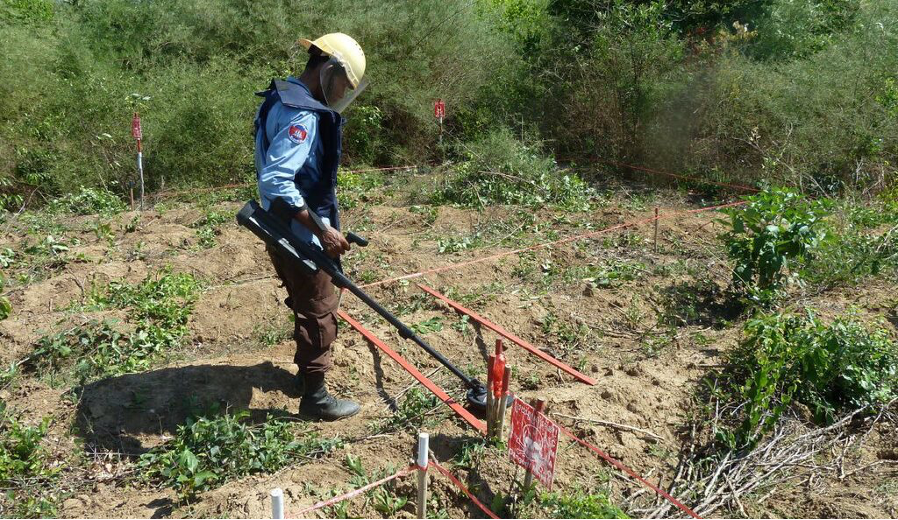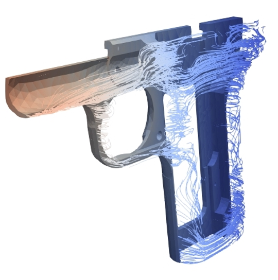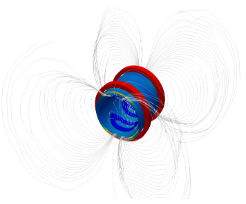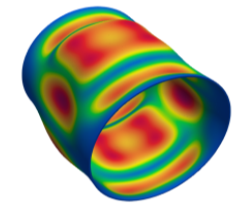Computational Mathematics/Mechanics
Our research uses computational mathematics and data science to predict of electromagnetically induced vibrations in MRI scanners and to characterise, locate and detect hidden threats to reduce the threat to public safety. We are also involved in developing novel numerical methods for fluid mechanics including CUDA GPGPU codes for the Navier-Stokes equations. For more information on PhD opportunities, please see here.
The United Nations (UN) have announced that “With more than 30,000 foreign terrorist fighters from some 100 countries around the world, terrorism is a global threat requiring a comprehensive and unified response.” This statement followed a spate of recent terrorist attacks, including those in France and Germany (July 2016), and a growing sense of global uncertainty in the western world. Promoting improvements to the identification and location of metallic threat items is an important aspect of the unified response and is an area where interdisciplinary mathematics and engineering can make a significant impact. Improvements in metal detection (MD) technology also provides wider benefits to the humanitarian cause of clearing landmines in developing countries. Wider benefits exist for the technology being transferred to MD companies developing devices for the non-destructive testing (NDT) of materials for safe structures, ensuring food safety, improved scrap metal sorting, as well as in medical imaging and archaeological searches.

Figure showing metal detecting for land mine surrogates in Cambodia.
Of course, current metal detectors do find highly conductive objects and their simple design (and portability) has made them a highly cost-effective modality for safety and security applications. Unfortunately, current technology is not able (or has limited capability) to distinguish between objects of different shape and materials of objects and can only detect objects within a small stand-off distance (or buried depth).
The EPSRC funded interdisciplinary collaborative research project “Reducing the threat to public safety: Improved object characterisation, location and detection” is addressing these issues by developing a new theory of metal detection (MD) and applying it to the characterisation, location and detection of realistic threat items by using, and enhancing, state-of-the-art measurement equipment. The project is running from 1st January 2018 to 30th June 2020 and is in collaboration with Department of Mathematics, The University of Manchester, the School of Electrical & Electronic Engineering, The University of Manchester and the Department of Mathematics at UCL. The industrial partners are DSTL, Rapiscan Systems and Safeline.
Advances made include the development of a new asymptotic expansions that describe electromagnetic field perturbations caused by the presence of small conducting objects, leading to new minimal characterisation of objects called magnetic polarisation/polarizability tensors [1]; the derivation of a complete asymptotic expansion, which characterises a homogeneous conducting object in terms of a new class of generalised polarizability tensors [2]; a new asymptotic expansion that describes the leading order term in the case of multiple inhomogeneous objects [3] and a detailed analysis that describes the spectral behaviour of the tensor coefficients and the associated improvements to metal detection using measurements made over a range of frequencies [4].
To compute such a characterisations, the open source mpt-calculator software has been developed for their computation, which uses a reduced order model based on proper orthogonal decomposition (POD) with certificates of accuracy and high order finite elements to compute the tensor coefficients of threat and non-threat objects [5].

Figure courtesy of Paul Ledger’s PhD Student Ben Wilson and showing computed contours and field lines for a vectoral solution to a transmission problem, used for computing the magnetic polarizability tensor characterisation of a replica TT-33 geometry.
Currently, probabilistic and non-probabilistic machine learning classification approaches to identify hidden targets are being explored, which also include measure of uncertainty.
To realise their practical application of the work, the articles [6,7] have been published in the electrical engineering literature and the work has also been publicised to the wider community through articles in the LMS newsletter and in The Engineer. These developments are being used to improve metal detector devices and deploy new algorithms for identifying hidden objects in applications such as airport and event security, landmine detection and recycling.
The work on developing new mathematics for metal detection work has been awarded prizes at conferences (eg at the 9th World Congress in Industrial Process Tomography) and has led to invitations for it to be presented at ETH Zurich (2019), the LMS-EPSRC Symposium, Durham University (2018) as well as numerous research seminars and conference presentations.
Collaborators
- Professor W.R.B. Lionheart, Department of Mathematics, The University of Manchester
- Professor A. Peyton, School of Electrical and Electronic Engineering, The University of Manchester
- Professor T. Betcke, Department of Mathematics, University College London.
Industrial partners
[1] P.D. Ledger, W.R.B. Lionheart. Characterizing the shape and material properties of hidden targets from magnetic induction data, IMA Journal of Applied Mathematics (2015) 80: 1776-1798 doi: 10.1093/imamat/hxv015
[2] P.D. Ledger, W.R.B. Lionheart. Generalised magnetic polarizability tensors. Mathematical Methods in the Applied Sciences, (2018) 41: 3175-3196 doi 10.1002/mma.4809
[3] P.D. Ledger, W.R.B. Lionheart and A.A.S. Amad. Characterisation of multiple conducting permeable objects in metal detection by polarisability tensors. Mathematical Methods in the Applied Sciences (2019), 42: 830-860 DOI:10.1002/mma.5387
[4] P.D. Ledger, W.R.B. Lionheart, Spectral properties of the magnetic polarisability tensor for metallic object characterisation. Mathematical Methods in the Applied Sciences (2020) 43: 78-113 DOI:10.1002/mma.5830
[5] B.A. Wilson, P.D. Ledger, Efficient computation of the magnetic polarizability tensor spectral signature using POD. Submitted 2020. Preprint available at arXiv:2001.07629
[6] P.D. Ledger, W.R.B. Lionheart. An explicit formula for the magnetic polarizability tensor for object characterisation. IEEE Transactions on Geoscience and Remote Sensing, (2018) 56: 3520-3533 doi 10.1109/TGRS.2018.2801359.
[7] P.D. Ledger, W.R.B. Lionheart. Understanding the magnetic polarizability tensor. IEEE Transactions on Magnetics (2016) 52: 6201216 doi: 10.1109/TMAG.2015.2507169
Magnetic resonance imaging (MRI) scanners have become an essential tool in the medical industry due to their ability to produce high-quality images of the human body. MRI scanners have been proven to be especially efficient in the diagnosis of vascular problems, tumors, or internal bleeding, among others. Superconducting MRI scanners are the most common type used for diagnostic imaging and they essentially consist of three main components: cryostat, main coils, and gradient coils. The cryostat is formed by several conducting radiation shields and an outer vacuum chamber that prevent radiation from heating the liquid helium that is used to keep the superconducting main coils at a temperature of 4 K. The main coils generate a strong static magnetic field, while the gradient coils generate time varying pulsed magnetic fields. These fields excite the protons in the human body generating a signal that is used to construct an image of the body.
The transient magnetic field generated by the gradient coils induces eddy currents in the conducting radiation shields, which leads to vibrations and the dissipation of heat. These vibrations cause a reduction in image quality, while the dissipation of heat can cause helium boil-off and potentially result in a magnet quench. To minimize these effects, a coupled physics magneto-mechanical problem described by a coupled the coupled system of Maxwell and elasticity partial differential equations must be solved.

Figure (left) Magnetom Lumina 3T. Image courtesy of Siemens Healthnieers; (right) illustration of MRI main components: main coils, gradient coils, and radiation shields (in-house software).
In collaboration with Siemens Healthineers and Professor Gil, Zienkiewicz Centre for Computational Engineering, Swansea University, computational approaches have been developed to predict these vibrations through an EPSRC funded CASE PhD studentship (2014-2017) and 2 Phd students funded the European Training Network, Admore(2016-2020).
Advances include the development of a new linearisation strategy for the coupled magneto-mechanical problem [1] and new accurate computational simulation tools using high order finite elements leading to accurate solutions for simplified axisymmetric geometries [2,3] and complex fully three-dimensional geometries on unstructured meshes [1]. In the latter, different sets of hierarchic basis functions are used for approximating the electromagnetic fields and the mechanical fields, as dictated by the weak form of the problem, and ensure that material interface conditions are properly enforced and that spurious solutions do not result. The linearisation strategy employed leads to an efficient computational implementation and the chosen basis function functions lend themselves to efficient preconditioning of the resulting linear systems.


Figure (Top) contour plot of static magnetic fields and streamlines of external current; (Bottom) contour plot of displacements
To accelerate the computation of solutions for engineering design, we have developed approaches that allow the rapid prediction of reduced order solutions for new model parameters of the coupled magneto-mechanical problem. These are based on novel versions of the Proper Orthogonal Decomposition (POD) and Proper Generalised Decomposition (PGD) algorithms. A projected POD approach has been developed [4] that utilises our linearisation strategy [1] for fast prediction of solutions for new frequencies and conductivities to the coupled magneto-mechanical set on complex fully three-dimensional geometries. In addition, a new PGD approach has been developed [5,6] for the rapid prediction of outputs from a larger dimension of parameters.
All approaches have been applied to realistic MRI geometries, benchmarked and tested.
Collaborators
- Professor A.J. Gil, Zienkiewicz Centre for Computational Engineering, Swansea University
- Dr Mike Mallett, Siemens Healthineers
[1] M. Seoane, P.D. Ledger, A.J. Gil and M. Mallett, An accurate three-dimensional high-order finite element methodology for the simulation of magneto-mechanical coupling in MRI scanners, International Journal for Numerical Methods in Engineering (2019) 119: 1185-1215
DOI: 10.1002/nme.6088
[2] S. Bagwell, P.D. Ledger, A.J. Gil, M. Mallett, M. Kruip. A linearised hp-finite element framework for acouto-magneto-mechanical coupling in axisymmetric MRI scanners. International Journal for Numerical Methods in Engineering (2017) 112: 1323-1352 doi: 10.1002/nme.5559
[3] S. Bagwell, P.D. Ledger, A.J. Gill, M. Mallett. Transient solutions to non-linear acouto-magneto-mechanical coupling for axisymmetric MRI scanner design International Journal for Numerical Methods in Engineering (2018) 115:20-9-237 doi: 10.1002/nme.5802.
[4] M. Seoane, P.D. Ledger, A.J. Gil, Zlotnik, M. Mallett, A Combined reduced order-full order methodology for the solution of 3D magneto-mechanical problems with application to MRI scanners. International Journal for Numerical Methods in Engineering (2020) 121: 3529-3559. DOI: 10.1002/nme.6369
[5] G. Barroso, M. Seoane, A.J. Gil, P.D. Ledger, M. Mallett, A. Heurta, A staggered high-dimensional Proper Generalised Decomposition for coupled magneto-mechanical problems with application to MRI scanners. Computer Methods in Applied Mechanics and Engineering (2020) 370: 113271. DOI: 10.1016/j.cma.2020.113271
[6] G. Barroso, A.J. Gil, P.D. Ledger, M. Mallett, A. Huerta, A regularised-adaptive proper generalised decomposition implementation for coupled magneto-mechanical problems with application to MRI scanners. Computer Methods in Applied Mechanics in Engineering (2020) 358: 112640 DOI:10.1016/j.cma.2019.112640
Researchers
Post-Doctoral Researchers
- Tatsuya Yasuda
- James Elgy
Projects
- Reducing the threat to public safety: Improved object characterisation, location and detection (Paul Ledger)
- Prediction of electromagnetically induced vibrations in MRI scanners (Paul Ledger)
- Object detection, location and identification at radio frequencies in the near field
- Generalised magnetic polarizability tensors: invariants and symmetry groups
PhD Students
Current
- Ben Wilson (at Swansea University)
- Edward Redfern (supervisor: Dan Lucas)
- Sayed Miah




